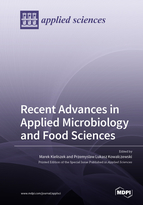Recent Advances in Applied Microbiology and Food Sciences
A special issue of Applied Sciences (ISSN 2076-3417). This special issue belongs to the section "Food Science and Technology".
Deadline for manuscript submissions: closed (31 July 2022) | Viewed by 41172
Special Issue Editors
Interests: biotechnology; microbiology; cancer; bacteria; selenium; biochemistry; yeast; food industry
Special Issues, Collections and Topics in MDPI journals
Interests: bioactive compounds; medicinal plants; antioxidants; edible insects; functional food; plant-based food additives; waste management in food system; plant-based meat analogues; biopolymers
Special Issues, Collections and Topics in MDPI journals
Special Issue Information
Dear Colleagues,
Progressive changes in technology also cause changes in the methods used in food research, including microbiological aspects. The cooperation of research centers with industry is also important, as it poses new challenges to science. This Special Issue is devoted to the latest achievements in analytics, and to the application of new methods in food production technology. We welcome both original research and review articles focused on recent advanced technology in food science and microbiology, especially modern methods of the production and testing of food as well as the sustainable development of agriculture and the food industry. This topic will cover research on microbiological food ingredients and related topics such as microbial metabolites with application in food and feed as preservatives, texturants, and beneficial microorganisms; flavors; and methods to study and modify microbiota. All types of articles are welcome, such as commentaries on innovative approaches, perspectives on microbiology, and reviews of the food industry.
Dr. Marek Kieliszek
Dr. Przemyslaw Lukasz Kowalczewski
Guest Editors
Manuscript Submission Information
Manuscripts should be submitted online at www.mdpi.com by registering and logging in to this website. Once you are registered, click here to go to the submission form. Manuscripts can be submitted until the deadline. All submissions that pass pre-check are peer-reviewed. Accepted papers will be published continuously in the journal (as soon as accepted) and will be listed together on the special issue website. Research articles, review articles as well as short communications are invited. For planned papers, a title and short abstract (about 100 words) can be sent to the Editorial Office for announcement on this website.
Submitted manuscripts should not have been published previously, nor be under consideration for publication elsewhere (except conference proceedings papers). All manuscripts are thoroughly refereed through a single-blind peer-review process. A guide for authors and other relevant information for submission of manuscripts is available on the Instructions for Authors page. Applied Sciences is an international peer-reviewed open access semimonthly journal published by MDPI.
Please visit the Instructions for Authors page before submitting a manuscript. The Article Processing Charge (APC) for publication in this open access journal is 2400 CHF (Swiss Francs). Submitted papers should be well formatted and use good English. Authors may use MDPI's English editing service prior to publication or during author revisions.







